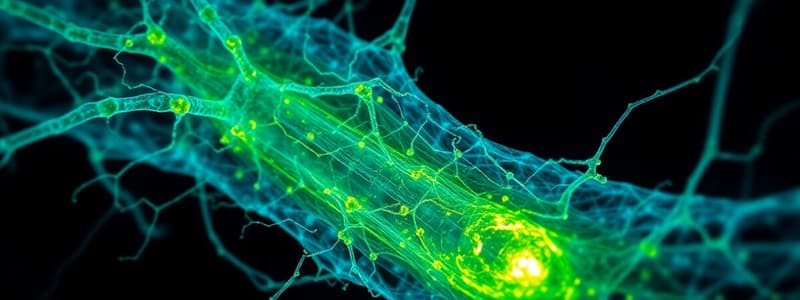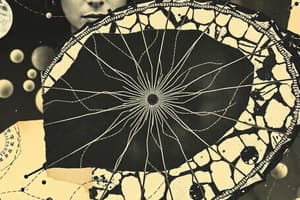Podcast
Questions and Answers
Which type of intermediate filament is found in muscle cells?
Which type of intermediate filament is found in muscle cells?
- Desmin (correct)
- Lamins
- Vimentin
- Neurofilaments
What is the diameter of intermediate filaments?
What is the diameter of intermediate filaments?
- 10 nm (correct)
- 100 nm
- 7 nm
- 25 nm
Which protein makes up the triplet arrangement in each centriole?
Which protein makes up the triplet arrangement in each centriole?
- Actin
- Vimentin
- Tubulin (correct)
- Keratin
Which of the following is NOT a function of the centrosome?
Which of the following is NOT a function of the centrosome?
Which intermediate filament is associated primarily with epithelial cells?
Which intermediate filament is associated primarily with epithelial cells?
What characterizes the structural composition of microtubules?
What characterizes the structural composition of microtubules?
In which type of cells is vimentin primarily found?
In which type of cells is vimentin primarily found?
What is the primary function of glycogen in cells?
What is the primary function of glycogen in cells?
What color does periodic-acid Schiff stain appear?
What color does periodic-acid Schiff stain appear?
In which type of cells is hemosiderin primarily found?
In which type of cells is hemosiderin primarily found?
What is the primary function of lipids in the body?
What is the primary function of lipids in the body?
Which of the following describes the appearance of lipids when stained with osmium tetroxide?
Which of the following describes the appearance of lipids when stained with osmium tetroxide?
What best describes the primary characteristic of intermediate filaments?
What best describes the primary characteristic of intermediate filaments?
What is the appearance of pigments like lipofuscin in cells?
What is the appearance of pigments like lipofuscin in cells?
What type of granules are observed in protein-synthesizing cells like salivary glands?
What type of granules are observed in protein-synthesizing cells like salivary glands?
Which of the following is NOT an endogenous pigment?
Which of the following is NOT an endogenous pigment?
What is the primary function of microfilaments in muscle cells?
What is the primary function of microfilaments in muscle cells?
Which of the following describes the structural protein that forms microtubules?
Which of the following describes the structural protein that forms microtubules?
What is the main role of intermediate filaments in the cytoskeleton?
What is the main role of intermediate filaments in the cytoskeleton?
Which characteristic distinguishes microtubules from microfilaments?
Which characteristic distinguishes microtubules from microfilaments?
Which proteins are involved in the movement of vesicles along microtubules?
Which proteins are involved in the movement of vesicles along microtubules?
What is a function associated with microfilaments during cell division?
What is a function associated with microfilaments during cell division?
How are microfilaments visualized in light microscopy?
How are microfilaments visualized in light microscopy?
What process is facilitated by microtubules in cellular function?
What process is facilitated by microtubules in cellular function?
Study Notes
Cytoskeleton
- Comprised of structural proteins, forming a non-membranous network in cells.
- Three primary types: microfilaments, microtubules, and intermediate filaments.
Microfilaments
- Diameter: 7 nm, visualized via immunohistochemical staining.
- Composed of G-actin monomers that polymerize into F-actin, arranged in a double helix.
- Functions include:
- Cell motility (migration, cytoplasmic streaming, cytokinesis, muscle contraction).
- Structural support (maintenance of cell shape, formation of microvilli core).
Microtubules
- Diameter: 25 nm, identifiable through immunohistochemical staining.
- Made of tubulin dimers (alpha and beta subunits) forming protofilaments, with 13 protofilaments composing a microtubule.
- Functions include:
- Transport of vesicles and organelles.
- Formation of mitotic spindles, centrioles, cilia, and flagella.
- Key players in cellular movement with motor proteins, kinesin and dynein, using ATP for transport.
Intermediate Filaments
- Diameter: 10 nm, visualized using immunohistochemical methods.
- Comprised of fibrous proteins, exhibiting a woven rope-like structure.
- The most stable cytoskeletal components, contributing primarily to structural integrity.
- Classified into cytoplasmic (e.g., keratin, vimentin, desmin) and nuclear types (lamins).
- Useful in cancer diagnostics through immunohistochemical staining, revealing tissue origin.
Centrosome
- A non-membranous organelle consisting of two centrioles oriented perpendicularly.
- Each centriole consists of 9 triplets of microtubules (totaling 27 microtubules).
- Functions include:
- Serving as a microtubule-organizing center.
- Facilitating formation of the mitotic spindle and cilia/flagella.
Cell Inclusions
- Defined as stored substances within cells, including food reserves and pigments.
Glycogen
- A carbohydrate storage form, primarily found in liver and muscle cells.
- Functions as a source of energy, appearing as dense granules in EM.
Lipids
- Serve as energy sources and building blocks for membranes and hormones.
- Stored mainly in adipocytes, visualized differently under various staining techniques.
Proteins
- Present in protein-synthesizing cells (e.g., salivary glands, pancreas).
- Visible as eosinophilic zymogen granules under LM and homogenous electron-dense granules in EM.
Pigments
- Endogenous Pigments:
- Hemoglobin in RBCs, hemosiderin in liver/spleen, melanin, and lipofuscin.
- Exogenous Pigments:
- Pigments introduced by tattooing, and accumulation of dust/smoke in the lungs.
Key Takeaway on Intermediate Filaments
- They are permanent structures that provide resistance against tension exerted on cells, contributing to overall cellular stability.
Studying That Suits You
Use AI to generate personalized quizzes and flashcards to suit your learning preferences.
Description
Test your knowledge on the cytoskeleton and cell inclusions with this quiz. Explore different types, structures, and functions of cytoskeletal components such as microfilaments, microtubules, and intermediate filaments, along with the role of centrosomes. Perfect for biology students and anyone interested in cell biology!



